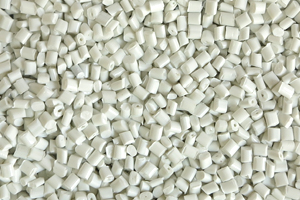Polystyrene(PS)

Polystyrene (PS) - Polystyrene is an amorphous, glassy polymer that is generally rigid and relatively inexpensive. Unfilled polystyrene has a sparkle appearance and is often referred to as crystal PS or general purpose polystyrene (GPPS). High impact polystyrene grades (HIPS) are produced by adding rubber or butadiene copolymer which increases the toughness and impact strength of the polymer. Polystyrenes possess good flow properties at temperatures safely below degradation ranges, and can easily be extruded, injection molded, or compression molded. Considerable quantities of polystyrene are produced in the form of heat-expandable beads containing a suitable blowing agent which ultimately results in familiar foamed polystyrene articles.
Polystyrene (PS) has been known for well over one hundred years but its real molecular nature was not clarified until about 1920 when the work of Staudinger elucidated the materials molecular structure in the very early days of polymer science. About 1930 I.G. Farben, in Germany, first produced polystyrene, while at the same time the Dow Chemical Company commenced their ultimately successful development of the material.
Features
High Impact Resistance, Flame Retardant, Food Contact Acceptable , Good Processability , General Purpose, High Heat Resistance , High Flow, Good Flow, Expandable, Fast Molding Cycle , ...
Uses
Packaging , Sheet , General Purpose , Insulation , Household Goods , Toys , Electrical/Electronic Applications , Containers , Foam , Appliance Components, ...
Disadvantages
- Flammable, but retarded grades available
- Poor solvent resistance, attacked by many chemicals
- Homopolymers are brittle
- Subject to stress and environmental cracking
- Poor thermal stability